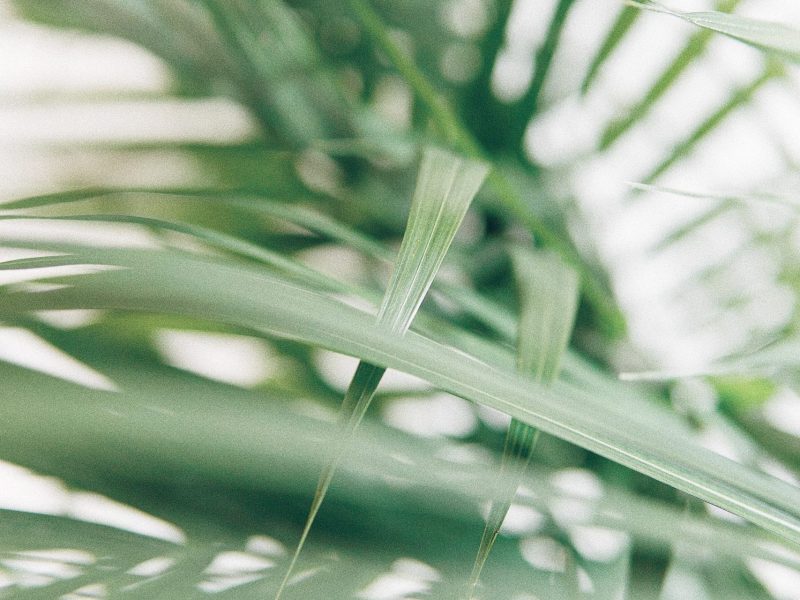
Kentia palms are great, slow growing indoor houseplant. There’s nothing worse than seeing the larger, old leaves or new growth coming through yellow instead of lovely deep green, so we found out what can cause that yellowing so it doesn’t happen to yours. Yellowing in the leaves of kentia palms is generally down to; improper lighting, incorrect watering practices, nutrient issues or just plain ageing of the plant.
Proper Lighting
Most kentia palms are grown in slightly shaded nurseries so they can survive indoors. However, naturally they grow in bright sunlight meaning they can deal with a whole range of light conditions. Everything apart from low light though so make sure they get adequate light throughout the day. They may take some time to adapt to their new light conditions, so if you plan on moving it into a brighter spot do slower move it over a couple of weeks. This will reduce the risk of the leaves suddenly burning. Using a light meter can take the guesswork out of knowing how much light is right for your Kentia Palm.
Watering issues can cause yellow leaves
As with a lot of things in the houseplant world, proper watering is an integral part of the puzzle. Palms that are kept indoors in slightly cooler climates and lower light won’t need excessive amounts of water. Keeping the soil evenly moist is a good bet, but they’ll do okay getting a little drier. Both too much and too little water can be a cause of yellowing leaves, so getting this right is pretty integral.
One of the simplest ways to make sure you’re watering correctly is the finger rule. Press one of your fingers around 1″ into the soil. If the soil is completely dry then you’re under-watering. If it’s super soggy, then you’re giving a little too much water. We also recommend using a moisture meter if you aren’t sure how moist the soil is as this is the most reliable way to tell if your Palm needs watering.
We’ve always gone for a little and often view towards watering. We’d recommend picking up your palm when it’s in need of watering and after you’ve watered it, this way you get a feel for when it might need a little more simply by giving it a little lift.
Complete Houseplant Care eBook
Our comprehensive (and rather good looking) eBook that will teach you everything you need to know to successfully care for, and maintain your houseplants!
Buy onYellow leaves can indicate poor drainage
Stagnant water in the bottom of the palms pot can leave the soil waterlogged. It’s important to make sure that the pot you’re using for your palm has sufficient drainage holes that aren’t blocked up and any decorative pots they’re sat in aren’t holding excess water.
You can very easily increase the amount of drainage in your palms by mixing in a little perlite with the soil, this will make it far easier for water to flow through and out of the drainage holes of the pot. Another easy step is to add a few small stones or pebbles to the bottom of your pots, this helps in making sure that the drainage holes are never blocked by soil or debris.
If you are using plastic pots then we also recommend switching to terracotta pots. These will allow some of the excess water to evaporate out of the sides of the pot if you accidentally overwater. We love these from Amazon.
Normal Growth & Ageing
One reason for yellowing leaves that we can’t put aside is simply that your palm is getting older. If the issues are towards the bottom of the palm and specifically with the older fronds then it’s not too much of a concern to the overall health. Generally, you should only be concerned if young or even new leaves are turning yellow, this could suggest some nutrient deficiencies.
Yellow leaves can also be caused by nutrient issues
Ideally, your kentia should be kept in a good, nutrient-dense soil with some mixed in compost. This should supply all of the essential nutrients for the development of new growth and continued health of the plant. If you spot that new growth is yellow or white then there are definitely some issues with the nutrient balance in the soil. While growth is a sign of nitrogen deficiency and yellow is a sign of a lack of magnesium, manganese, iron or potassium issues. If this is happening to your palm, try repotting with a high-quality potting mix. You’ll also want to use a well-balanced liquid fertiliser like this one from Miracle Gro to ensure your Kentia Palm is getting the right mix of nutrients.
To find out more about Kentia Palm care, visit our guide. There you will find everything you need to know to keep your Kentia Palm healthy and thriving as well as tips and tricks around propagation, fertilisation and repotting.














